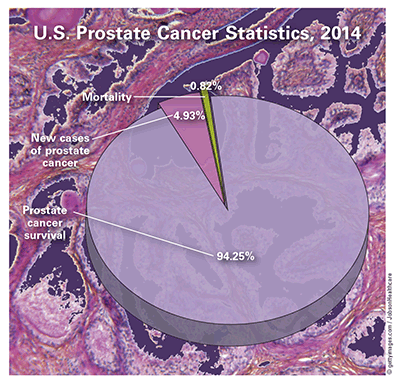US Pharm. 2017;42(8):Epub.
Prostate cancer is the number-one cancer risk for men. It is estimated that, by 2024, more men (4.2 million; 45%) will get prostate cancer than women will get breast cancer (4 million; 41%), and 11.6% of men will be diagnosed at some point in their life. The risk grows if two or more of a man’s close relatives were diagnosed or if a man is diagnosed before age 55 years. About one in three men whose fathers or brothers had prostate cancer will develop this disease. Although the median age at diagnosis is 66 years, two of every three cases occur in men aged 65 years and older. Most cases are confined to the primary site (79%), 12% of cases spread to the regional lymph nodes, and a small number of cases metastasize (5%).

New Cases: In 2014, of all new cancer cases, 9.6% (119.8/100,000 men) were prostate cancer. Prostate cancer is rare before age 40 years, but the risk grows with age. The rate of new cases increased from 9.3% in men aged 45 to 54 years to 32.8% in those aged 55 to 64 years and peaked at 38.2% in those aged 65 to 74 years, after which it dropped to 15.3% and 3.9% in men aged 75 to 84 years and >84 years, respectively. Forty percent fewer cases of prostate cancer occurred in white men (112.8/100,000) than in black men (188.7/100,000). It is estimated that 180,000 new cases of prostate cancer will be diagnosed in 2017.
Mortality: Annually, more than 27,000 men die from prostate cancer. In 2014, 12.4% fewer deaths were attributable to prostate cancer (21.8/100,000) than in 2010, with an average of 3.2% deaths per year. Prostate cancer accounted for 4.4% (20.1/100,000) of all cancer deaths. The death rate was 9.1% in men aged 55 to 64 years and doubled in those aged 65 to 74 years (21.3%), peaking at 34.4% in those aged 75 to 84 years and then dropping marginally in those aged >84 years (33.5%). The prostate cancer death rate was about five times higher in black men (42/100,000) than in Asian/Pacific Islanders (8.8/100,000).
Survival: Because of early detection, 98% of men with prostate cancer have a 10-year relative survival rate. The average 5-year survival rate for late-stage prostate cancer is 2 to 3 in 10 men. More than 2.9 million men diagnosed with prostate cancer at some point are still living. Higher-risk men could benefit from prostate screening before age 55 years, although men aged 55 to 69 years who are not at higher risk benefit the most from such tests.
To comment on this article, contact rdavidson@uspharmacist.com.





